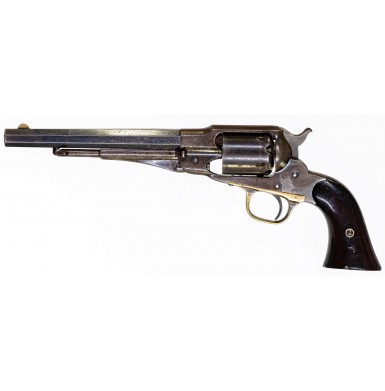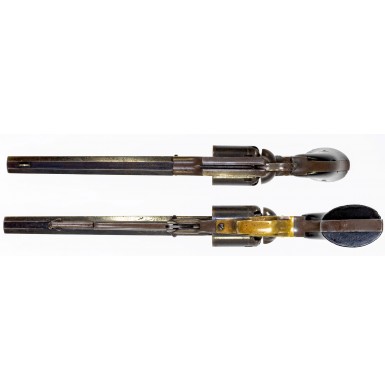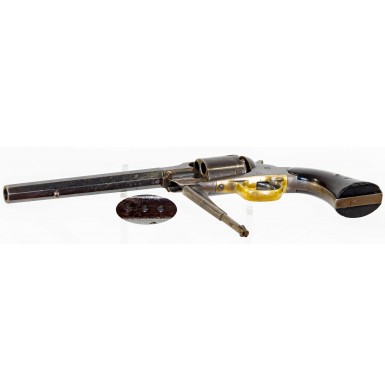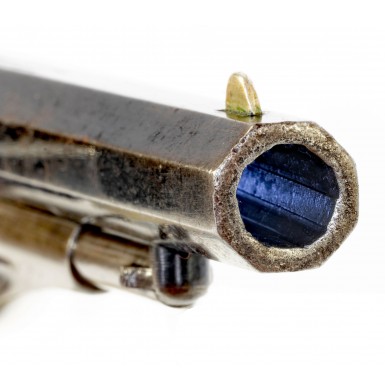Scarce Remington New Model Police Revolver with Rare 6.5" Barrel
- Product Code: FHG-3515
- Availability: Out Of Stock
-
$2,295.00
In 1865, as the American Civil War was coming to an end, the firm of E. Remington & Sons began to look at the reality of an immediate future without large US military manufacturing contracts as their primary market. This meant that for the foreseeable future civilian sales would likely be the bulk of Remington’s business, unless they could secure peacetime contracts with the US government or military contracts with foreign governments. Remington no doubt knew that large numbers of inexpensive surplus military percussion revolvers would soon be flooding the market, so there was no point in pursuing larger, holster pistol part of the market for the foreseeable future.
One of the primary indications of the firm’s change in business strategy was the introduction of the two new, more concealable handguns clearly destined for the civilian market. These were the New Model Pocket Revolver and the New Model Police Revolver. Both were based upon Remington’s successful line of New Model military revolvers which were the final evolution of designs that had begun 1857 with Fordyce Beals’ first design. The New Model Pocket Revolver was a diminutive spur trigger concealable handgun in .31 caliber. The New Model Police was a scaled down version of the New Model Navy revolver, which retained the .36 caliber bore of its larger sibling.
The Remington New Model Police revolver was clearly inspired by Colt’s Model 1862 Pocket Navy and Pocket Police revolvers. It has often been said that “imitation is the sincerest form of flattery” but it is worth noting that copying an idea that was not particularly successful is not always the best business move. From a sales perspective the Colt 1862 series of handguns were not very successful, with only about 47,000 of both 1862 models being produced between 1861 and 1873. For comparison the Colt Model 1849 Pocket Revolver reached production numbers in excess of 330,000 between 1849 and 1873 and the Model 1851 Navy Revolver reached production figures in excess of 215,000 during its 23-year production run from 1850-1873. Broken down for average production per year over the period of time they were offered, an average of more than 13,000 Colt Pocket revolvers were produced per year, more than 9,000 Colt Navy revolvers were produced per year and slightly less than 4,000 of the 1862 series guns were produced per year. Had Remington looked at the production figures they might not have embarked on their New Model Police project because it had similarly lack luster success.
The genesis of what would become the Remington New Model Police Revolver began in 1857, when the firm of E. Remington & Sons of introduced their first percussion revolver. Since the founding of the firm in 1816 by Eliphalet Remington, the company had concentrated on the production of gun parts, primarily rifle barrels, and then long arms. In 1856, with the addition of Remington’s three sons to the business, the firm officially became E. Remington & Sons. The following year, their first revolver was ready for sale, the Remington-Beals Pocket revolver. This was the invention of Remington employee Fordyce Beals. Beals had been instrumental in the production of the Jenks carbine contract, and had actually been acquired from Ames, as had the machinery, as part of the negotiated arrangement between Remington and Ames. Beals’ design was a compact, single action, .31 caliber revolver that bore a resemblance to the “Walking Beam” revolver then in production by Whitney. This should come as no surprise as the Whitney revolver was based upon Beals’ 1854 patent which evaded Colt’s protection of his pistol’s mechanism. In 1856, Beals patented the features that were salient to his new Remington revolver, and in 1858 patented the cylinder pin and loading lever system that would define the silhouette of all the large-frame Remington handguns for some three decades, through the Model 1875 which would remain in the product line through 1889.
Beals’ 1858 patent (#21,478) was granted on September 14th of that year and covered the winged cylinder arbor pin that secured the cylinder to the frame, which was retained by the loading lever located under the barrel and could be withdrawn from the frame only when the lever was lowered. Thus, began the evolution of the second most used US marital revolver of the American Civil War. The first guns were produced in .36 caliber and production started to roll off the assembly line during late 1860 or early 1861. The .36 caliber “Navy” revolver was followed by a .44 caliber “Army” variant soon thereafter. By the time Beals-Navy production ended in 1862, some 15,000 of the handguns had been produced, while only about 2,000 of the larger “Army” revolvers were manufactured, before the William Elliott “improved” Model 1861 pattern Remington revolvers (also known to collectors as the “Old Model”) superseded the Beals model.
The Beals Navy Revolver was Remington’s first large frame, martial handgun to make it into production. The earlier Beals “Army”, a scaled-up version of the pocket model, was only produced as a prototype and it is believed that less than 10 were manufactured. The Beals Navy was a single action, 6-shot revolver with a nominally 7 ½” octagonal barrel that was screwed into the solid frame. While most references list the barrel length as 7 ½” some of the earlier examples measure closer to 7 3/8” in length. The guns were blued throughout, with brass triggerguards and a color casehardened hammer. The gun had two-piece smooth walnut grips, secured by a screw that passed through German silver escutcheons and a cone shaped German silver front sight was dovetailed into the top of the barrel near the muzzle. There were a number of differences between the Beals model and the later production “Old Model” 1861 and the final “New Model” 1863 revolvers. The most obvious visual differences were the “high spur” hammer and the fact that frame concealed the barrel threads at the rear of the barrel. Shortly after the “Old Model” 1861 went into production, these features were eliminated. A relief cut in the frame revealing the threads at the barrel’s end was added to reduce the possibility of cylinder lock up due to fouling and a lower spur hammer was adopted eventually to reduce the potential for breakage. The system of retaining the cylinder arbor pin via the loading lever evolved as well. While the Beals revolver required the lever to be lowered to withdraw the pin, the Model 1861 included a relief cut in the top of the lever that allowed the pin to be pulled forward with the lever in its upright and locked position. This was considered an improvement, and the feature was patented by Remington employee William Elliot, who would be responsible for a number of successful Remington firearms designs. This “improvement” proved to be a failure in the field, as the arbor pin could slide forward in the relief cut under recoil. When this happened, the cylinder often locked up, making the revolver useless. An eventual “fix” was developed for this potentially fatal flaw. A filister head screw was added to the inside of the loading lever that acted as a stop against the cylinder pin. This meant that the lever again had to be lowered to remove the pin, essentially returning the design to the original Beals concept and nullifying Elliot’s improvement.
The Beals models did not have safety notches on the rear of the cylinder that would allow the hammer to be safely dropped and locked between cylinder chambers. This feature was added to the Model 1861 and 1863 revolvers. Other minor evolutions occurred as well, including making the loading lever slightly larger and more robust. As the Beals was the first of the large frame martial Remington revolvers it underwent some changes and improvements during its production.
The US government had been relatively pleased with the original Beals Navy design and had obtained some 11,249 of the 15,000 Beals Navy revolvers produced. The purchases had been a combination of direct contract with Remington combined with open market purchases of some 7,250 revolvers that would not pass through a government inspection process. In June of 1862, the Ordnance Department let a contract for 5,000 additional “Navy” caliber revolvers to Remington. The guns delivered under this contract appear to be a combination of late Remington Beals Navy revolvers and the new Model 1861 Elliott revolvers. The serial numbering of the Model 1861 revolvers continued from the Beals Navy revolvers, with the numbers mixing somewhat randomly at the end of Beals production and the beginning of Model 1861 production. This can probably be attributed to the using up of older parts on hand, thus the existence of “transitional” Remington Navy revolvers. Between August and December of 1862, a total of 5,001 .36 Remington Revolvers were delivered under this contract. Due to reports of issues in the field with the new Elliott Model 1861 revolvers, modifications and improvements occurred during the production of the “Old Model” Navy revolvers, which eventually morphed into the “New Model” or Model 1863 revolvers. Interestingly after finally getting the Remington Navy design to its pinnacle, no additional .36 caliber revolvers would be purchased from Remington by the Ordnance Department after the final December 1862 deliveries. Instead, the US military decided to concentrate on the acquisition of .44 caliber percussion revolvers and a large number of the New Model 1863 Army revolvers would be acquired between 1863 and 1865. In fact, roughly 80,000 of the New Model Army revolvers were purchased during the last two years of the war, while Remington would only produce about 22,000 New Model Navy percussion revolvers from the time of their introduction until the summer of 1871 when percussion production of that model came to a halt. In all some 148,000 “Army” sized Remington revolvers of all variants were produced with only about 48,000 of the “Navy” sized guns produced during the same period.
In 1865 a scaled down version New Model Navy, which was marketed as the New Model Police revolver, was added to the Remington line up. The gun had a smaller frame, a five rather than six shot smooth round cylinder, and was offered in barrel lengths that ranged from 3.5” to 6.5” in one-inch increments. The shorter barrel lengths were more conducive to concealment and discrete carry. Like the standard New Model Navy revolver, the gun had a removable winged cylinder arbor pin that was held in place by the loading lever and safety notches on the rear face of the cylinder. Initially the standard finish was blued, with the hammer color case hardened and the brass triggerguard silver plated. Later production guns were offered in nickel or a combination of nickel and blue, similar to Smith & Wesson’s “Half Plate” silver and blue finish. Grips were two-piece smooth walnut that were varnished, rather than oil finished as on the military revolvers. The front sight was a German silver blade, and the rear sight was groove in the topstrap. To say that sales were lackluster would be an understatement. During the brief production period from 1865-1873 only about 18,000 of the revolvers were produced, with many never leaving the factory as percussion handguns, but rather as cartridge conversions in .38RF. Some were even shipped as dual cylinder guns, with both a cartridge and percussion cylinder provided. Many factors certainly contributed to the lack of success of the design. The fact that so many inexpensive surplus military revolvers were on the market certainly hurt sale. For the buyer who was looking for the power of a .36 handgun in a smaller package, the Colt offerings had already been on the market for about three years, giving Colt a market share advantage. Additionally, for those truly looking for a concealable handgun, the New Model Police did not necessarily offer the size advantages of a true pocket-sized handgun, particularly in the longer barreled versions. Finally, the end of the percussion era had arrived and the public in search of a new, mid-sized self-protection handgun was certainly being drawn to the advantages of new self-contained metallic cartridge revolvers. All of these factors combined to make the Remington New Model Police one of the least common of Remington handguns from the immediate post-Civil War era, particularly in percussion.
Offered here is a FINE condition example of a Remington “New Model” Police Revolver. This revolver is number 944and was likely produced sometime circa 1865. The serial number is present on the frame under the left grip and under the barrel where it is concealed by the loading lever. The grips are often numbered in pencil on their interiors, but no number is visible in these grips, but it may simple be too weak to see. As usual for these revolvers, the cylinder is not serial numbered. The revolver is equipped with the 6.5” barrel, which is the longest and one of the most desirable variants of these guns. The 6.5” octagonal barrel of the revolver is roll marked in three lines on the top flat:
PATENTED SEPT. 14, 1858
E. REMINGTON & SONS ILION, NEW YORK U.S.A.
NEW MODEL
As noted, the revolver remains in FINE condition and retains some nice original finish. The revolver is extremely crisp throughout with sharp edges and mostly clear markings. The gun retains about 30%+ of its original blued finish overall, with the barrel and cylinder retaining the most finish and the loading lever the next largest amount of finish. The frame retains some traces of blue, mostly in protected areas. The balance of the metal has a mottled and lightly oxidized brownish-gray patina with scattered freckles of oxidized discoloration and a few scattered patches of minor surface roughens on the barrel. The loss of blue appears to be primarily from flaking, with the oxidized freckling likely the result of poor storage. The hammer retains some strong traces of its original color casehardening and has a pleasing mottled bluish appearance, even if the colors have dulled, muted and weak. The triggerguard retains some traces of tarnished silver plating in the protected areas. The gun also shows some scattered minor dings and impact marks, primarily in the region of the frame and barrel junction, on both sides.
The bore of the revolver is in FINE condition as well. It is mostly bright and retains extremely crisp rifling throughout. The bore shows some very lightly scattered areas of surface oxidation, some lightly scattered minor pitting, and some moderate frosting in the grooves. The revolver remains in mechanically excellent condition and functions correctly in every way. The revolver times, indexes and locks up exactly as it should. The loading lever functions smoothly and locks into place securely. The cones (nipples) all appear to be original and although they all show moderate wear, they all appear to be fully functional. The original German silver blade front sight is in place on the top of the barrel near the muzzle and remains fully height and is not worn down or damaged. The two-piece smooth, varnished walnut grips remain NEAR FINE condition as well and are quite nice. They are solid and are free of any breaks, cracks, or repairs. The grips are fairly crisp but do show some numerous scattered minor bumps, dings, mars, and handling marks, as well as some minute loss at the sharp leading edges on the bottom.
Overall, this is a really very nice and very crisp example of a fairly scarce Remington “New Model” Police Revolver. The gun retains much of its original finish and is nice and crisp throughout. Only about 18,000 of these revolvers were produced during their fairly brief production run and many of those left the factory as either cartridge altered guns were actually produced as cartridge revolvers and were never assembled as percussion handguns. These are hard guns to find in any condition and are revolver missing from many collections of Civil War era and mid-19th century Remington percussion revolvers.
ON HOLD/LAYAWAY
Tags: Scarce, Remington, New, Model, Police, Revolver, with, Rare, 6.5", Barrel










